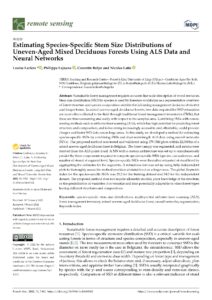
Abstract:
Sustainable forest management requires accurate fine-scale description of wood resources. Stem size distribution (SSD) by species is used by foresters worldwide as a representative overview of forest structure and species composition suitable for informing management decisions at shorter and longer terms. In mixed uneven-aged deciduous forests, tree data required for SSD estimation are most often collected in the field through traditional forest management inventories (FMIs), but these are time-consuming and costly with respect to the sampled area. Combining FMIs with remote sensing methods such as airborne laser scanning (ALS), which has high potential for predicting forest structure and composition, and is becoming increasingly accessible and affordable, could provide cheaper and faster SSD data across large areas. In this study, we developed a method for estimating species-specific SSDs by combining FMIs and dual-wavelength ALS data using neural networks (NNs). The proposed method was tested and validated using 178 FMI plots within 22,000 ha of a mixed uneven-aged deciduous forest in Belgium. The forest canopy was segmented, and metrics were derived from the ALS point cloud. A NN with a custom architecture was set up to simultaneously predict the three components required to compute species-specific SSDs (species, circumference, and number of stems) at segment level. Species-specific SSDs were thereafter estimated at stand level by aggregating the estimates for the segments. A robustness test was set up using fully independent plots to thoroughly assess the method precision at stand-level on a larger area. The global Reynolds index for the species-specific SSDs was 21.2 for the training dataset and 54.0 for the independent dataset. The proposed method does not require allometric models, prior knowledge of the structure, or the predefinition of variables; it is versatile and thus potentially adaptable to other forest types having different structures and compositions.
Consultez la notice complète de l’article sur ORBi
